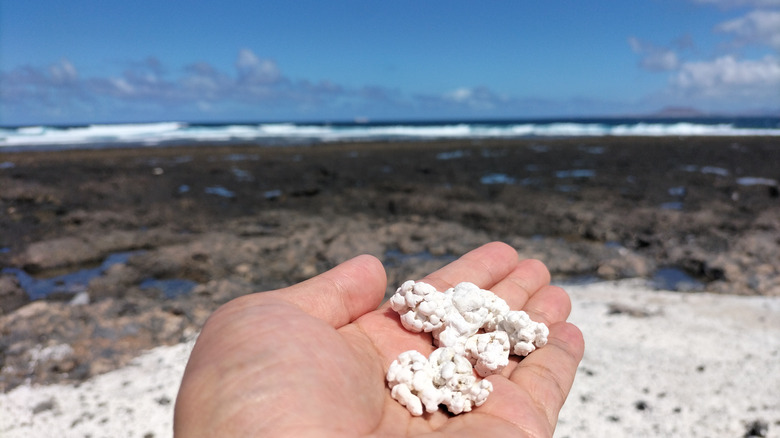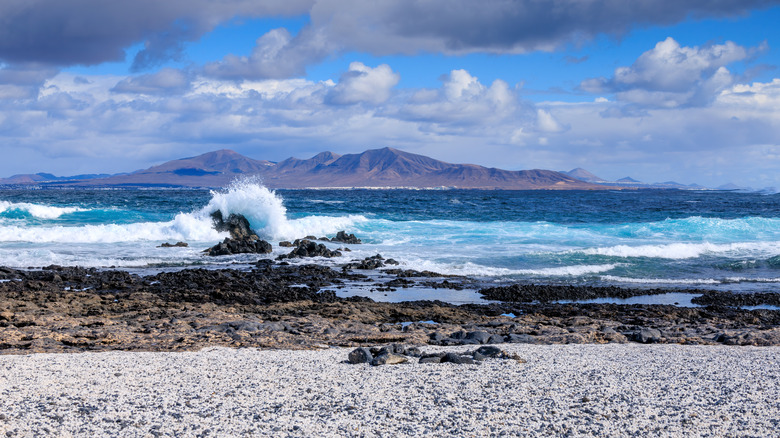Beaches come in many different forms. There are rocky beaches, grassy ones, others that only have pebbles, and many, obviously, have sand. That sand can come in a rainbow of colors, from white to yellow to black, red, or even green. However, there is one place in the world that has a very unique and unusual type of sand. Though, to be accurate, it’s not really sand at all. This beach has a covering that is made from coral fossils and looks exactly like the beach is covered in popcorn.
Even better? This popcorn beach is on Fuerteventura, one of the Canary Islands, a Spanish autonomous communityoff the northwest coast of Africa. That means this beach is in a beautiful place that is just perfect for a vacation. The beach is called Playa del Bajo de la Burra, or simply Playa del Bajo. It’s the best place to find these unique food-shaped fossils, though there are other popcorn beaches nearby, such as El Hierro. Let’s talk about how this popcorn covering ended up on the beach, the pirate legend that centers on this area, and how to get there in the first place.
Why it looks like you can eat the beach

So why does the beach look like someone had a big movie screening the night before and forgot to clean the popcorn off the floor? The name “popcorn sand” comes from what it looks like, of course, but the fragments you’re actually seeing are called rhodoliths. These are the remains of coral that have been buffed by waves. It is believed that some of them could be 4,000 years old. Considering that the coral these popcorn-appearing pieces come from grows about a millimeter a year, having bits of the beach that are that old makes sense.
One thing to keep in mind if you decide to visit Playa del Bajo de la Burra: You cannot take the popcorn sand home. Think about it for a moment. It takes these creatures hundreds and hundreds of years to grow, then the beach full of their remains took millennia to build up to its current form. You can capture the phenomenon in pictures and put them all over your social media accounts, but please leave them on the beach where you found them. Some estimates say that tourists take about 22 pounds of this beach home with them every month, adding up to around 264 pounds a year. There are campaigns in motion to keep people from taking it right now, including a $3,275 fine! Just don’t do it.
How to get to Playa del Bajo de la Burra and the pirate legend

It’s pretty easy to get to Fuerteventura. There are ferries every day from the Spanish islands of Tenerife, Gran Canaria, and Lanzarote (whose volcanic peaks you can spy from Fuerteventura, as you can see in the picture above). You can drive to the beach, or hike about an hour from the town of Corralejo to get there. There is even a little cafe for snacks.
And now, the moment you’ve been waiting for. Pirates! There is a legend that says a pirate ship was sailing around the island centuries ago. A crew member said there was treasure here, so they stopped, but he was really trying to escape. It didn’t work. In 1998, the remains of a ship were found that date from the late 1800s. If you happen to find that legendary treasure — if it ever existed — do let us know. Though the treasure part of it might not be real, you can take one of several pirate tours around the island.
If you’re staying on Fuerteventura, you should visit Corralejo Natural Park, which has impressive sand dunes and is near the same town you hike to the beach from. There are plenty of regular sand beaches to lounge on as well. You can also hire a guide to hike Calderón Hondo, which is a volcanic crater around 30 million years old. Remember your sunscreen because this is around 912 feet above sea level and you burn faster at higher elevations.

